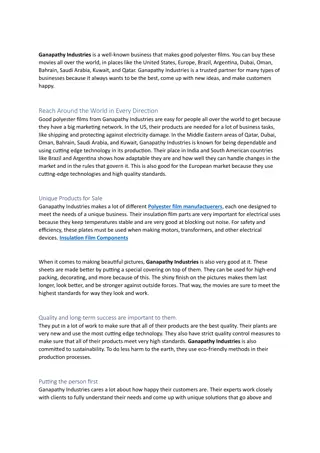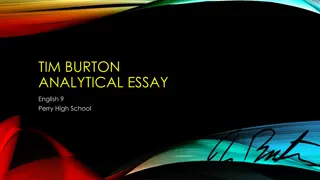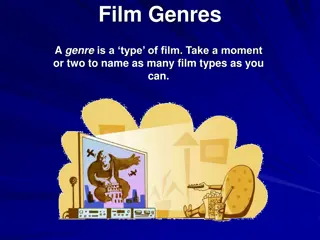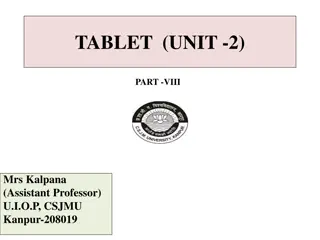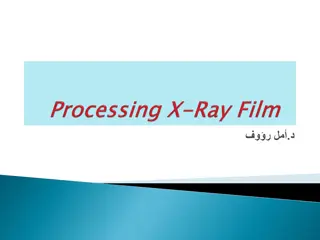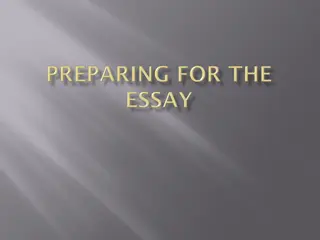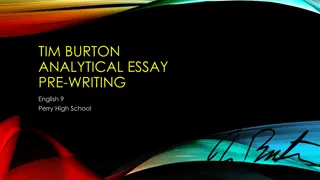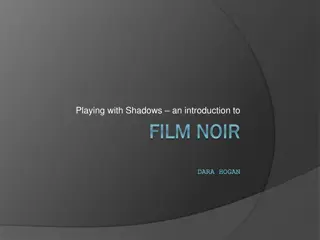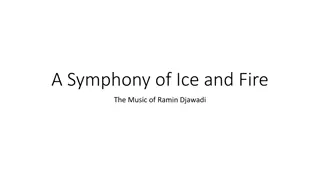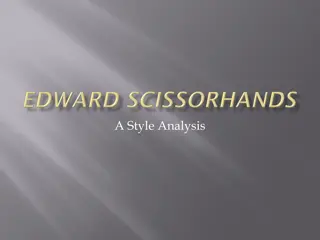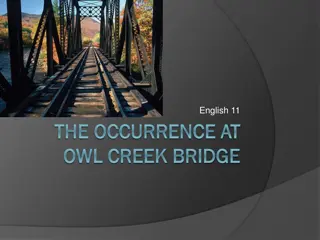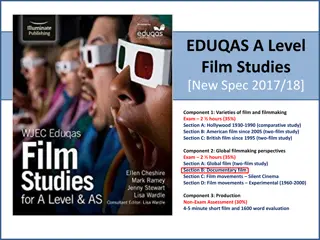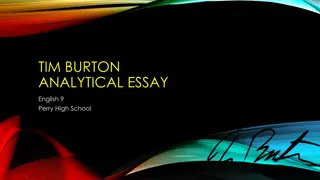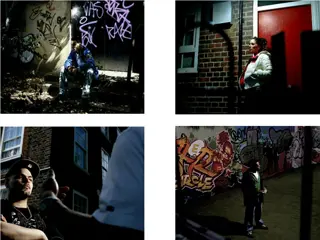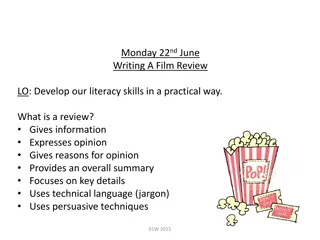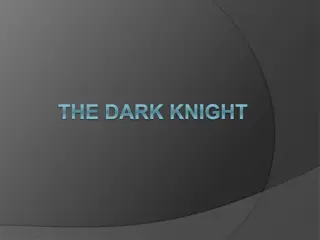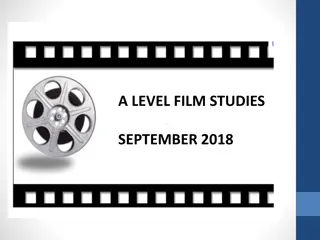Understanding Cinematic Techniques in Film Analysis
Dive into the realm of film analysis by exploring how directors use cinematic techniques to convey specific effects in their visual storytelling. Learn about shots, framing, camera angles, and movements, drawing parallels to how writers utilize point of view in literature. Discover the significance of establishing shots, long shots, medium shots, close-ups, extreme close-ups, and two shots through examples from iconic movies like Titanic, Spiderman 2, The Shining, and Tangled.
Download Presentation

Please find below an Image/Link to download the presentation.
The content on the website is provided AS IS for your information and personal use only. It may not be sold, licensed, or shared on other websites without obtaining consent from the author. Download presentation by click this link. If you encounter any issues during the download, it is possible that the publisher has removed the file from their server.
E N D
Presentation Transcript
Working with Cinematic Techniques English 9 Modified SB 2.15
Film Analysis Much like how a writer uses stylistic devices to achieve specific effects in their writing, directors use cinematic techniques in their films for specific purposes. In order to analyze a film through critical viewing like you do a text in critical reading, you must understand the tools that filmmakers use to create their visual masterpieces.
SHOTS and FRAMING, CAMERA ANGLES and CAMERA MOVEMENTS All compare to how a writer uses POINT OF VIEW Shot: a single piece of film uninterrupted by cuts Of course, different shot types, angles and movements achieve different effects
ESTABLISHING SHOT - Often a long shot or a series of shots that sets the scene; is used to establish setting and to show transitions between locations From the TV Show Seinfeld
LONG SHOT a shot from some distance. If filming a person, the full body is shown. It may show the isolation or vulnerability of the character From the movie Titanic
MEDIUM SHOT the most common shot. The camera seems to be a medium distance from the object being filmed. A medium shot shows the person from the waist up. The effect is to ground the story. From the movie Spiderman 2
CLOSE UP the image takes up at least 80 percent of the frame From the movie The Shining
EXTREME CLOSE UP the image being shot is a part of a whole, such as an eye or a hand
TWO SHOT a scene between two people shot exclusively from an angle that includes both characters more or less equally. It is used in love scenes where the interaction between two characters is important. From the movie Tangled
EYE LEVEL a shot taken from normal height; that is, the character s eye level. Ninety to ninety-five percent of the shots seen are eye level, because it is the most natural angle. From the movie Toys
HIGH ANGLE the camera is above the subject. This usually has the effect of making the subject look smaller than normal, giving him or her the appearance of being weak, powerless or trapped. From the movie Psycho
LOW ANGLE the camera films subject from below. This usually has the effect of making the subject look larger than normal, and therefore strong, powerful, and threatening. From the movie Alice in Wonderland
CAMERA MOVEMENTS Pan stationary camera moves from side to side on a horizontal axis Tilt a stationary camera moves up or down along a vertical axis Zoom a stationary camera where the lens moves to make an object seems to move closer or further away from the camera. *With this technique, moving into a character is often a personal or revealing movement, while moving away distances or separates the audience from the character. Dolly/Tracking the camera is on a track that allows it to move with the action. The term also refers to any camera mounted on a car, truck, or helicopter. Boom/Crane the camera is on a crane over the action. This is used to create overhead shots.
CAMERA MOVEMENTS Use of Dolly/Tracking and Boom/Crane to shoot Transformers
LIGHTING Compares to how a writer establishes tone and mood in their work Lighting creates significant emotional responses from the audience based on what people associate with light and darkness Lighting effects clarity, realism and emotion
HIGH KEY the scene is flooded with light; creating a bright and open-looking scene From the movie Shawshank Redemption
LOW KEY the scene is flooded with shadows and darkness, creating suspense and suspicion From the movie Insidious
Bottom or Side Lighting direct lighting from below or the side, which often makes the subject appear dangerous or evil From the movie The Blair Witch Project
Front or Back Lighting soft lighting on the actors face or from behind which gives the appearance of innocence or goodness, or a halo effect. From the movie The Princess and the Frog
Editing Techniques Compares to how a writer uses syntax Cut two pieces of film are spliced together to cut to another image Fade can be to or from black and white; implies the passing of time or the end of a scene Fade-In darkness to brightness Fade-Out image gradually gets darker Dissolve a kind of fade in which one image is gradually replaced by another Wipe a new image wipes off the previous image (quicker than a dissolve)
Editing Techniques Continued Flashback cut or dissolve to action that happened in the past Shot-Reverse-Shot a shot of one subject, then another, than back to the first; often used for conversation or reaction shots Cross-Cutting cut into action that is happening simultaneously; creates tension or suspense and creates a connection between scenes Eye-Line Match cut to an object, then to a person; can reveal a character s thoughts
Sound Compares to how a writer establishes tone and mood in their work Diegetic sound that can logically be heard by the characters in the film (dialogue, background noise, sound of things in the scene) Non-Diegetic sound that cannot be heard by the characters but is designed for the audience reaction only (ominous music or sounds)
Apply It! Watch the guided viewing of the clip from Rocky IV. http://www.youtube.com/watch?v=VgSMxY6asoE CLAP every time you see the cut ! Note examples from the mini-movie of SHOTS and FRAMING, CAMERA ANGLES, CAMERA MOVEMENTS, LIGHTING, EDITING and MUSIC/SOUND on the chart on pg. 137 in your SpringBoard book. Your teacher will stop the video as needed for discussion/note- making.











